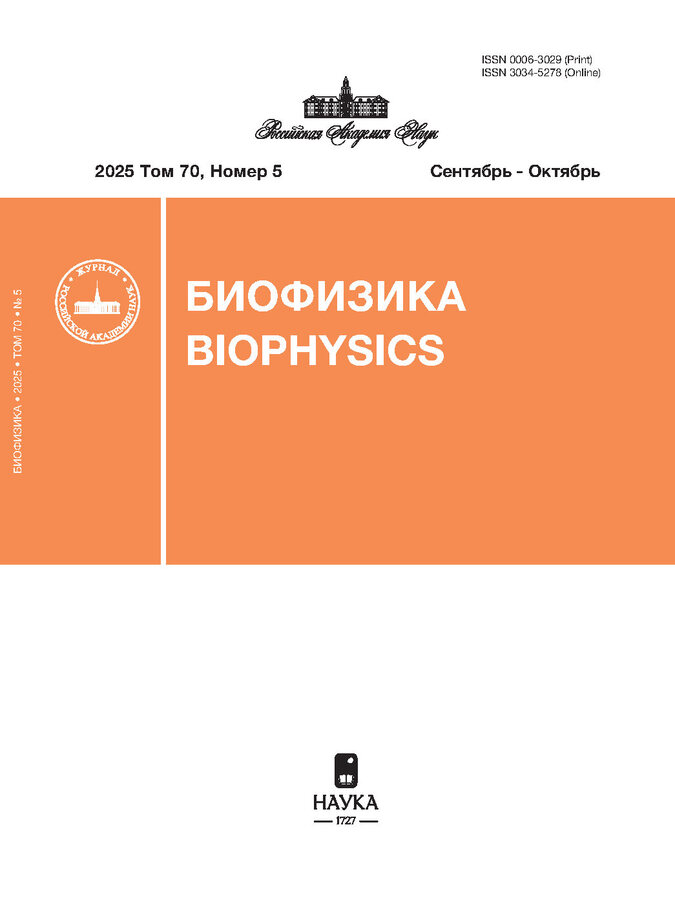ДЕЙСТВИЕ ДИНИТРОЗИЛЬНЫХ КОМПЛЕКСОВ ЖЕЛЕЗА С ЛИГАНДОМ НА ОСНОВЕ N-АЦЕТИЛ-L-ЦИСТЕИНА ПРИ ИНГАЛЯЦИОННОМ ВВЕДЕНИИ ЭТИХ КОМПЛЕКСОВ В ОРГАНИЗМ КРЫС
- Авторы: Тимошин А.А1, Шумаев К.Б1,2, Лакомкин В.Л1, Абрамов А.А1, Рууге Э.К1,3
-
Учреждения:
- Национальный медицинский исследовательский центр кардиологии имени академика Е.И. Чазова Минздрава России
- Институт биохимии имени А.Н. Баха, Федеральный исследовательский центр «Фундаментальные основы биотехнологии» Российской академии наук
- Московский государственный университет имени М.В. Ломоносова
- Выпуск: Том 69, № 6 (2024)
- Страницы: 1329-1334
- Раздел: Биофизика cложныx cиcтем
- URL: https://gynecology.orscience.ru/0006-3029/article/view/676164
- DOI: https://doi.org/10.31857/S0006302924060181
- EDN: https://elibrary.ru/NJUWPO
- ID: 676164
Цитировать
Полный текст
Аннотация
Об авторах
А. А Тимошин
Национальный медицинский исследовательский центр кардиологии имени академика Е.И. Чазова Минздрава России
Email: timoshin_a_a@mail.ru
Москва, Россия
К. Б Шумаев
Национальный медицинский исследовательский центр кардиологии имени академика Е.И. Чазова Минздрава России; Институт биохимии имени А.Н. Баха, Федеральный исследовательский центр «Фундаментальные основы биотехнологии» Российской академии наукМосква, Россия
В. Л Лакомкин
Национальный медицинский исследовательский центр кардиологии имени академика Е.И. Чазова Минздрава РоссииМосква, Россия
А. А Абрамов
Национальный медицинский исследовательский центр кардиологии имени академика Е.И. Чазова Минздрава РоссииМосква, Россия
Э. К Рууге
Национальный медицинский исследовательский центр кардиологии имени академика Е.И. Чазова Минздрава России; Московский государственный университет имени М.В. ЛомоносоваФизический факультет Москва, Россия
Список литературы
- Ke C.-H., Chen C.-H., Tsai M.-L., Wang H.-C., Tsai F.-T., Chiang Y.-W., Shih W.-C., Bohle D. S., and Liaw W.-F. {Fe(NO)2}9 dinitrosyl iron complex acting as a vehicle for the NO radical. J. Am. Chem. Soc., 139 (1), 67— 70 (2017). doi: 10.1021/jacs.6b11454
- Shumaev K. B., Kosmachevskaya O. V., Timoshin A. A., Vanin A. F., and Topunov A. F. Dinitrosyl iron complexes bind with hemoglobin as markers of oxidative stress. Methods Enzymol., 436, 445-461 (2008). doi: 10.1016/S0076-6879(08)36025-X
- Suryo Rahmanto Y., Kalinowski D. S., Lane D. J., Lok H.
- C., Richardson V., and Richardson D. R. Nitrogen monoxide (NO) storage and transport by dinitrosyl-dithiol-iron complexes: long-lived NO that is trafficated by interacting proteins. J. Biol. Chem., 287 (10), 6960-6968 (2012). doi: 10.1074/jbc.R111.329847
- Tsai M.-L., Tsou C.-C., and Liaw W.-F. Dinitrosyl iron complexes (DNICs): From biomimetic synthesis and spectroscopic characterization toward unveiling the biological and catalytic roles of DNICs. Acc. Chem. Res., 48, 1184-1193 (2015). doi: 10.1021/ar500459j
- Vanin A. F., Poltorakov A. P., Mikoyan V. D., Kubrina L. N., and Burbaev D. C. Polynuclear water-soluble Dinitrosyl Iron Complexes with cysteine and glutathione ligands: electron paramagnetic resonance and optical studies. Nitric Oxide, 23 (2), 136-149 (2010). doi: 10.1016/j.niox.2010.05.285
- Vanin A. F. Dinitrosyl iron complexes with thiol-contain-ing ligands as a “working form” of endogenous nitric oxide. Nitric Oxide, 54, 15-29 (2016). doi: 10.1016/j.niox.2016.01.006
- Vanin A. F. Physico-chemistry of dinitrosyl iron complexes as a determinant of their biological activity. Int. J. Mol. Sci., 22 (19), 10356 (2021). doi: 10.3390/ijms221910356
- Dungel P., Perlinger M., Weidinger A., Redl H., and Kozlov A. V. Cytoprotective effect of nitrite is based on the formation of dinitrosyl iron complexes. Free Radic. Biol. Med., 89, 300-310 (2015). doi: 10.1016/j.freeradbiomed.2015.08.012
- Shumaev K. B., Dudylina A. L., Ivanova M. V., Pugachenko I. S., and Ruuge E. K. Dinitrosyl iron complexes: Formation and antiradical action in heart mitochondria. BioFactors, 44 (3), 237-244 (2018). doi: 10.1002/biof.1418
- Shumaev K. B., Gorudko I. V., Kosmachevskaya O. V., Grigoryeva D. V., Panasenko O. M., Vanin A. F., Topunov A. F., Terekhova M. S., Sokolov A. V., Cherenkevich S. N., and Ruuge E.K. Protective effect of dinitrosyl iron complexes with glutathione in red blood cell lysis induced by hypochlorous acid. Oxid. Med. Cell. Longev., 2019, e2798154 (2019). doi: 10.1155/2019/2798154
- Timoshin A. A., Lakomkin V. L., Abramov A. A., Ruuge E. K., Kapel’ko V. I., Chazov E. I. and Vanin A. F. The hypotensive effect of the nitric monoxide donor Oxacom at different routs of its administration to experimental animals. Eur. J. Pharmacol., 765, 525—532 (2015). doi: 10.1016/j.ejphar.2015.09.011
- Шумаев К. Б, Петрова Н. Э., Заббарова И. В., Ванин А. Ф., Топунов А. Ф., Ланкин В. З. и Рууге Э. К. Взаимодействие оксоферрилмиоглобина и динитрозильных комплексов железа. Биохимия, 69 (5), 699-705 (2004). EDN: ORCNPN
- Шумаев К. Б., Космачевская О. В., Грачев Д. И., Тимошин А. А., Топунов А. Ф., Ланкин В. З. и Рууге Э. К. Возможный механизм антиоксидантного действия динитрозильных комплексов железа. Биомед. химия, 67 (2), 162-168 (2021). doi: 10.18097/PBMC20216702162
- Тимошин А. А., Шумаев К. Б., Лакомкин В. Л., Абрамов А. А. и Рууге Э. К. Исследование методом электронного парамагнитного резонанса транслокации стабилизированных форм NO через кожный покров крыс. Бюл. эксперим. биологии и медицины, 170 (9), 290-295 (2020). doi: 10.47056/0365-9615-2020-170-9-290-295
- Тимошин А. А., Шумаев К. Б., Лакомкин В. Л., Абрамов А. А. и Рууге Э. К. Действие динитрозильных комплексов железа с лигандом на основе N-ацетил-L-цистеина при сублингвальном введении этих, комплексов в организм крыс. Биофизика, 67 (3), 581-586 (2022). doi: 10.31857/S0006302922030188
- Ванин А. Ф., Пекшев А. В., Вагапов А. Б., Шарапов Н. А., Лакомкин В. Л., Абрамов А. А., Тимошин А. А. и Капелько В. И. Газообразный оксид азота и динитрозильные комплексы с тиолсодержащими лигандами как предполагаемые лекарственные средства, способные купировать COVID-19. Биофизика, 66 (1), 183-194 (2021). doi: 10.31857/S0006302921010208
- Timoshin A. A., Pisarenko O. I., Lakomkin V. L., Studneva I. M., and Ruuge E. K. Free radical intermediates in isolated rat heart during perfusion, ischemia, and reperfusion: effect of ischemic preconditioning. Exp. Clin. Cardiol., 5 (2), 59-64 (2000). EDN: LFYTAF
- Ванин А. Ф., Абрамов А. А., Вагапов А. Б., Тимошин А. А., Пекшев А. В., Лакомкин В. Л. и Рууге Э. К. Почему вдыхание газообразного оксида азота не влияет на системное артериальное давление у человека и животных? Биофизика, 68 (6), 1259-1264 (2023). doi: 10.31857/S0006302923060170
- Freeman B. A., O’Donnell V. B., and Schopfer F. J. The discovery of nitro-fatty acids as products of metabolic and inflammatory reactions and mediators of adaptive cell signaling. Nitric Oxide, 77, 106-111 (2018). doi: 10.1016/j.niox.2018.05.002
- Vanin A. F. What is the mechanism of nitric oxide conversion into nitrosonium ions ensuriong S-nitrosating processes in living organisms. Cell Biochem. Biophys., 77 (4), 279-292 (2019). doi: 10.1007/s12013-019-00886-1
- Massa C. M., Liu Z., Taylor S., Pettit A. P., Stakheyeva M. N., Korotkova E., Popova V., Atochina-Vasserman E. N., and Gow A. J. Biological Mechanisms of S-Nitrosothiol Formation and Degradation: How Is Specificity of S-Nitrosylation Achieved? Antioxidants, 10 (7), 1111 (2021). doi: 10.3390/antiox10071111
- Vanin A. F. and Timoshin A. A. Determination of in vivo nitric oxide levels in animal tissues using a novel spin trapping technology. Methods Mol. Biol., 704, 135-149 (2011). doi: 10.1007/978-1-61737-964-2_11
- Bosworth C. A., Toledo J. C., Zmijewski J. W., Li Q., and Lancaster J. R. Dinitrosyliron complexes and the mechanism(s) of cellular protein nitrosothiol formation from nitric oxide. Proc. Natl. Acad. Sci. USA, 106 (12), 46714676 (2009). doi: 10.1073/pnas.0710416106
Дополнительные файлы








